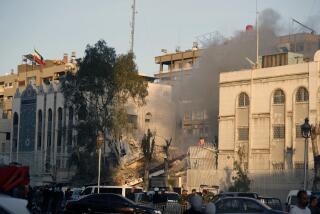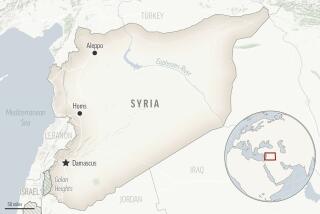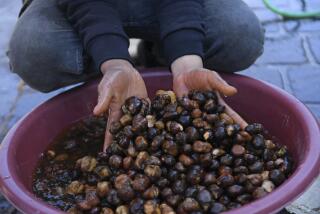Syria has faced international condemnation for using chemical weapons. But Islamic State has them too
When the Syrian town of Khan Sheikhoun was hit this month with an attack of poison gas, the incident drew international condemnation and prompted the Trump administration to launch a retaliatory missile strike.
On Friday, there was another incident: A rocket loaded with chlorine gas struck the neighborhood of Abar in the Iraqi city of Mosul, injuring several soldiers. This one, though, was not fired by the government. Iraqi military officials said it was launched by the militant group Islamic State.
As the U.S. government backed by the international community continues to draw a red line around the Syrian government’s use of chemical weapons in its long-running war against Islamic State and other rebels, there is growing evidence that deadly chemical agents are also becoming part of the jihadist group’s arsenal.
Islamic State has used chemical weapons, including chlorine and sulfur, at least 52 times on the battlefield in Syria and Iraq, according to a study released in November by IHS Conflict Monitor, a London-based intelligence collection and analysis service.
The Organization for the Prohibition of Chemical Weapons said it had confirmed that Islamic State fighters had deployed sulfur mustard, commonly known as mustard gas, in an attack on the Syrian town of Marea, near Aleppo, in August 2015. The internationally banned substance burns a victim’s skin, throat and eyes.
“In this case, the team was able to confirm with utmost confidence that at least two people were exposed to sulfur mustard, and that it is very likely that the effects of this chemical weapon resulted in the death of an infant,” the organization said in a statement.
There have been other cases:
On March 4, a dozen civilians from east Mosul were treated for suspected exposure to a blistering chemical agent after several rocket attacks by Islamic State, according to an Iraqi military official. The patients, including a 2-month-old baby, were transferred to a hospital in Irbil for treatment of symptoms of a chemical attack including blisters, burns, respiratory problems, irritation to the eyes and vomiting, the official said.
In northern Iraq, Islamic State fired mortar rounds loaded with sulfur mustard at Kurdish forces in October 2015, the Organization for the Prohibition of Chemical Weapons said.
“There has been no question of where those mustard agents came from,” said Jerry Smith, former operations chief for the organization.
Chemical weapons such as chlorine gas, mustard gas and sarin are banned by most nations. They are especially difficult to defend against without protective gear, which is mostly absent on the battlefield in Iraq and Syria.
The attacks officials blame on Islamic State and other forces have not generated the death and destruction associated with the chemical attacks attributed to the Syrian government.
The attack this month in the rebel-held town of Khan Sheikhoun killed 86 people. The government of President Bashar Assad has denied responsibility and blamed opposition forces. It has also suggested the poison gas was inadvertently released during an airstrike on a rebel-held munitions depot.
In 2013, the U.S. and Syrian opposition groups accused forces loyal to Assad of lobbing sarin-filled shells at rebel-held enclaves near Damascus. According to U.S. estimates, more than 1,000 people were killed.
As a result, a deal pushed by Russia saw the government surrender its stockpiles of chemical weapons to the United Nations.
More than 95% of the government’s arsenal was eliminated, according to the Organization for the Prohibition of Chemical Weapons. But the organization also said there have been chemical attacks since then by rebel and government forces.
Chlorine is commercially available as an industrial chemical and has been used by militant bomb makers in Iraq for years. But it was unclear how Islamic State obtained sulfur mustard.
Smith said militants could make warfare-grade mustard and chlorine “fairly easy.”
Former CIA Director John Brennan, who stepped down in January, said in an interview last year with CBS’ “60 Minutes” that Islamic State had “the ability to manufacture small quantities of chlorine and mustard gas.”
The U.S.-led coalition has targeted Islamic State munitions depots and weapon-manufacturing sites with airstrikes in Iraq and Syria.
“We’ve long known that the enemy has aspired to use chemical weapons,” U.S. Col. John Dorrian, a Baghdad-based coalition spokesman, said at a briefing in February. “Mustard agent is one that they’ve used many times.”
Dorrian called militants’ capability to make chemical weapons “rudimentary,” but he emphasized that it was “very important that we continue to roll back their control of territory because this is not something that we want to wait and let [Islamic State] get good at.”
Smith thought it unlikely that militants had stockpiled large quantities of chemical weapons.
“If ISIS had manufactured these weapons, I’m sure we would have seen them used by now, with half of Mosul gone,” he said, suing an acronym for the militant group. “By this stage, I would have thought we’d have seen them and lots of them.”
Daryl Kimball, executive director of the Washington–based Arms Control Assn., said some Islamic State units “have produced an improvised mustard gas type of shell” from mustard seeds in makeshift chemical laboratories, “but not chlorine.”
The chemical weapons could have been seized from industrial or Syrian government stockpiles, he and other experts said.
The governments of former Iraqi dictator Saddam Hussein and Assad once sponsored chemical warfare programs.
Assad was to hand over Syria’s chemical weapons — including chlorine and nerve gas — to Smith’s monitoring group to be destroyed four years ago. Smith said that his team removed weapons the government declared, but that “it was on a bit of a trust basis.”
Kimball noted Smith’s group had difficulty checking the Syrian government’s compliance.
“There were some areas the government would not allow them to go to verify it had been handed over,” he said of the chemical weapons. “It’s possible even if they did turn everything over, they maintained the capacity and knowledge to manufacture the precursors.”
The U.N. has since found Syrian military helicopters dropped bombs containing chlorine on civilians in at least two attacks over the last three years.
Islamic State doesn’t have the capacity to manufacture the more lethal nerve agents like sarin, Kimball said, but it could attack and seize whatever Syrian authorities refused to turn over.
“There has been a deep concern that the Syrian stockpile might fall into the wrong hands,” he said. “We now have to be focused on removing whatever nerve agents in Syria still exist.”
ALSO
These Syrians were finally being evacuated to safety. That’s when the bomb went off
At least 100 Syrians killed in bomb attack on evacuation bus convoy near Aleppo
Syrians leave family, memories behind as tens of thousands are evacuated in previously brokered deal
More to Read
Start your day right
Sign up for Essential California for news, features and recommendations from the L.A. Times and beyond in your inbox six days a week.
You may occasionally receive promotional content from the Los Angeles Times.







